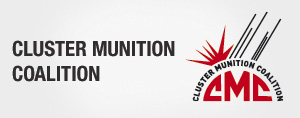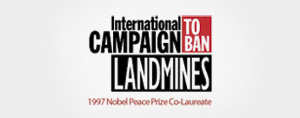31 October 2010
Cluster Munition Monitor 2010 Press Release
EMBARGOED UNTIL 04:00 GMT, 1 NOVEMBER 2010
SWIFT IMPLEMENTATION OF CLUSTER MUNITION BAN SAVES LIVES
According to Cluster Munition Monitor 2010 released today
BANGKOK, 1 November 2010 – The destruction of millions of stockpiled cluster submunitions years before deadlines mandated under the Convention on Cluster Munitions—a legally-binding treaty banning the weapon which entered into force on 1 August 2010—shows the treaty’s effectiveness in saving civilian lives, according to Cluster Munition Monitor 2010, a report released today.
Seven states that have joined the convention have already completed destruction of their stockpiles of cluster munitions, destroying more than 13.8 million submunitions contained in 176,000 cluster munitions. At least eleven other countries are currently destroying their stocks.
“There is real momentum behind the ban on cluster munitions,” said Steve Goose of Human Rights Watch, Cluster Munition Monitor’s Final Editor, citing the impressive number of signatories to the ban convention, the short time to bring it into force, and the rush to implement its life-saving provisions. “It is encouraging to see so many countries showing such commitment to eradicating cluster munitions and their severe impact on civilians now and forever,” said Goose.
The convention obliges States Parties to end use, production, and transfer of cluster munitions immediately, destroy stockpiled cluster munitions within eight years of joining the convention, clear land contaminated by cluster munitions within 10 years, and assist the victims of these weapons. The convention was negotiated in May 2008, opened for signature in December 2008, and became binding international law on 1 August 2010.
Among the 108 countries that have signed the convention are 38 former users, producers, exporters, or stockpilers of the weapon. Of these signatories, 42 have now ratified the convention, and 10 have already enacted national legislation to implement the convention.
Over the past six decades cluster munitions have been used in 39 countries and areas by at least 18 governments. Since the convention was opened for signature in December 2008, there has only been one serious allegation of cluster munition use, by the United States on an alleged al-Qaeda training camp in Yemen in December 2009. The US government has yet to confirm or deny this charge, and neither the US nor Yemen has joined the convention.
At least 38km2 of land, an area roughly the size of Chiang Mai, Thailand was cleared of cluster munition remnants in 2009, with more than 55,156 unexploded submunitions destroyed. States Parties Albania and Zambia have announced the completion of their clearance programs. Clearing contaminated land will prevent thousands of casualties.
However, according to Stuart Casey-Maslen of Norwegian People’s Aid, the Monitor’s Mine Action Editor, “While mine action programs exist in almost all cluster-munition-affected states and areas, their scope and productivity must increase to release land more quickly and save lives.”
Cluster munition contamination remains in at least 23 states, including 14 that have joined the convention, as well as three disputed areas. The most-affected regions are Southeast Asia and Europe, while the countries and areas with the most contamination include Lao PDR, Vietnam, Iraq, Cambodia, Lebanon, Serbia, Nagorno-Karabakh, and Western Sahara.
In 2009, there were 100 new confirmed cluster munition casualties in nine states and one area. Half of these casualties occurred in just two states, Lao PDR and Lebanon, both of which have joined the Convention on Cluster Munitions.
As of the end of 2009, 16,816 cluster munition casualties had been recorded in at least 27 states and three areas, including 15 states that have joined the convention. Due to significant underreporting, the actual number of cluster munition casualties might be as high as 85,000 worldwide. According to Katleen Maes of Handicap International, the Monitor’s Casualties and Victim Assistance Editor, “There is a need for swift and efficient aid to cluster munition victims. The convention provides ground-breaking provisions for victim assistance and if states properly fulfill their obligations these can significantly improve the lives and livelihoods of survivors, their families, and communities.”
The 27 states with cluster munition victims each provide survivors with some care, but the majority of victims lack comprehensive assistance, particularly economic inclusion and psychosocial support. Access in rural areas is especially difficult.
A total of US$13.2 million in funding related to cluster munitions was reported by seven states in 2009, including $4.15 million via the Cluster Munitions Trust Fund for Lao PDR.
This is the first Cluster Munition Monitor report, the sister publication to the Landmine Monitor report, which has been issued annually since 1999. Cluster Munition Monitor 2010 covers cluster munition ban policy, use, production, trade, and stockpiling for every country in the world, and also includes information on cluster munition contamination, casualties, clearance, and victim assistance. The report covers the period from May 2009, with information included up to August 2010 when possible.
Cluster Munition Monitor 2010 is being released in advance of the First Meeting of States Parties to the Convention on Cluster Munitions, being held in Vientiane, Lao PDR from 9–12 November 2010.
Landmine and Cluster Munition Monitor is coordinated by an Editorial Board drawn from five organizations: Mines Action Canada, Action On Armed Violence, Handicap International, Human Rights Watch, and Norwegian People’s Aid. It constitutes a sustainable and systematic way for non-governmental organizations to monitor and report on the implementation of humanitarian and disarmament treaties.
Landmine Monitor was created in June 1998 by the Nobel Peace Prize-winning International Campaign to Ban Landmines. In 2008, Landmine Monitor also functionally became the research and monitoring arm of the Cluster Munition Coalition. In 2010, the initiative changed its name to Landmine and Cluster Munition Monitor (known as “the Monitor”) to reflect its increased reporting on the cluster munition issue.
Cluster Munition Monitor 2010 and related documents are available at 04:00 GMT on 1 November here.
For more information or to schedule an interview, contact:
- Conor Fortune, CMC Communications and Media Officer, Bangkok (GMT+6), Mobile +44-75-1557-5174 or +66-88-091-9372, email conor@stopclustermunitions.org
- Jacqueline Hansen, Landmine and Cluster Munition Monitor Program Manager, Bangkok (GMT+6), Mobile +1-613-851-5436 or +66-88-091-9373, email jackie@icbl.org



